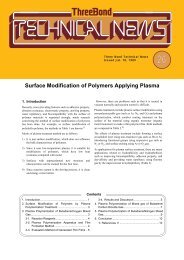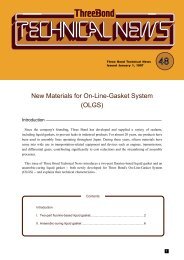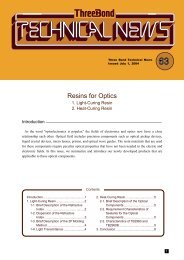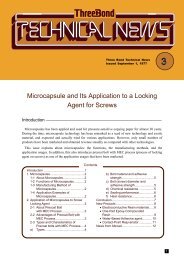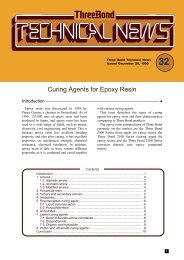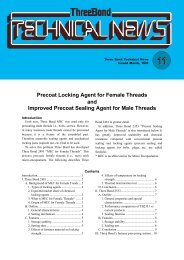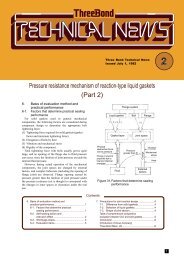New Light-Curing Instant Adhesives (ThreeBond 1771E, 1773E, and ...
New Light-Curing Instant Adhesives (ThreeBond 1771E, 1773E, and ...
New Light-Curing Instant Adhesives (ThreeBond 1771E, 1773E, and ...
You also want an ePaper? Increase the reach of your titles
YUMPU automatically turns print PDFs into web optimized ePapers that Google loves.
2. Characteristics of light-curing instant adhesives2-1. <strong>Curing</strong> mechanismAs shown in Figure 1, a light-curing instantadhesive cures on irradiation by ultraviolet orvisible light, thanks to a photo polymerizationinitiator contained in the adhesive that decomposes<strong>and</strong> generates anion species (Nu - (nucleophile)),which then advances anion polymerization.Conventional light-curing resins include radicalpolymerization <strong>and</strong> cation polymerization typeresins. Much technological expertise hasaccumulated for radical polymerization type resinsin particular, resulting in a wide range of adhesivesbased on various resin combinations.Among these, anion types (including instantadhesives) that use anion species as polymerizationinitiators remain at the stage of basic research dueto their instability <strong>and</strong> h<strong>and</strong>ling difficulty. Onlyseveral studies have been reported to date. Kutal<strong>and</strong> Yamaguchi et al. (University of Georgia, 2))reported that 2-cyanoacrylic acid esters undergophoto-induced polymerization with the addition ofmetallocene derivatives such as benzoylferrocene.However, the report addresses only aspects such as:"increased viscosity" <strong>and</strong> "gelation," with nodiscussion of preservation stability. In short, thereport is not useful in advancing practical adhesiveapplications.Our research has shown that radical generatorssignificantly activate the reactivity of the aboveferrocene derivative. We have succeeded indeveloping light-curing instant adhesives withexcellent light-curing properties <strong>and</strong> goodpreservation stability through concurrent use ofadhesives <strong>and</strong> radical generators.As shown in Figure 3, light-curing instantadhesives are activated by light irradiation, whichcures excess adhesive that laps from the adherendsof bonded materials. Based on instant adhesives, theportion between the adherends cures instantly bymoisture curing, as do conventional instantadhesives.AdherendsUltraviolet or visible light<strong>Curing</strong> as a conventional instant adhesiveFigure 3: <strong>Curing</strong> mechanism<strong>Curing</strong> by opticalanion polymerization2-2. Characteristics of light-curing instantadhesives<strong>Light</strong>-curing instant adhesives combine both lightcuring <strong>and</strong> moisture curing. This combinationreduces bleaching effect <strong>and</strong> improves surfacecuring <strong>and</strong> filling bonding properties, <strong>and</strong> vastlyexp<strong>and</strong>s applications.Table 3 compares the characteristics oflight-curing instant adhesives, conventional instantadhesives, <strong>and</strong> typical light-curing resin.Table 3:Bonding of light-blocking materials<strong>Curing</strong> of excess portionsSurface curing propertyBleachingTemporary retaining jigsCharacteristics of light-curing instantadhesives<strong>Instant</strong>adhesivesNot required<strong>Light</strong>-curing instantadhesivesNot required<strong>Light</strong>-curingresinsRequired(1) Good bonding properties for light-blockingmaterialsAlthough transparent materials pose no problems,ordinary light-curing resins fail to cure when usedto bond light-blocking materials, as shown in Figure3, since the materials block light. In contrast,light-curing instant adhesives cure instantly viamoisture curing in the gaps between adherends.<strong>Light</strong>-curing instant adhesives are thus associatedwith lower incidence of curing failures thanlight-curing resins due to insufficient lightirradiation, even for transparent adherends.(2) Good surface curing of excess adhesivesprevents bleaching effectWhile conventional instant adhesives cureinstantly in the gaps between adherends, excessadhesive remaining as a liquid cures slowly,reacting with airborne moisture. This behavior isdue to an imbalance between the acid stabilizer <strong>and</strong>the alkaline initiator, with too much stabilizer forthe amount of moisture. Under these conditions, themonomer gas evaporates readily <strong>and</strong> promotesbleaching effect. In contrast, light-curing instantadhesives <strong>and</strong> light-curing resins require only lightto cure.It should be noted that oxygen inhibits the curingof light-curing resins that cure by radicalpolymerization, resulting in poor surface curingcharacteristics.(3) No fixing jig required at bonding4



